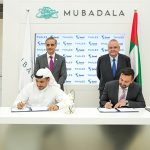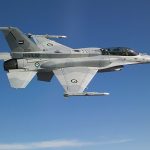In conversation with Sulaiman Al Ali, Executive VP of Yahsat Government Solutions, we explore what the UAE satellite operator brought to the Dubai Airshow.
 What did you bring to the Dubai Airshow this year?
What did you bring to the Dubai Airshow this year?
We showcased the combined reach and capabilities of the Yahsat-Thuraya aero mobility portfolio that is powered by Ka-, Ku- and L-bands. We highlighted the airborne satcom heritage of Yahsat Government Solutions, enhanced through our acquisition of Thuraya. The Yahsat network is now capable of supporting aero mobility through Yahsats fleet (AY1, AY2 and AY3) and Thurayas satellites (T2 and T3).
Can you share some use cases of your integrated aero mobility solutions with us?
We recently conducted demos of Thurayas aero mobility capabilities on fixed-wing aircraft for key government customers in Austria and Abu Dhabi. Both were very successful and well received.
The live airborne streaming sessions, organised in partnership with SCOTTY, an Austrian developer of BLOS satellite communications solutions, and Diamond Aircraft Industries, replicated real-time ISR (Intelligence, Surveillance and Reconnaissance) missions in which live surveillance imagery, flight tracking and duplex data were transmitted to mission control centres over Thurayas L-band network. Consisting of a high-gain antenna and an aeronautical satellite modem, Thuraya Aero provides airborne access to secure IPs and VPNs, connecting mission-critical operations on land, sea and air simultaneously.
The technology demonstrations highlighted the reliability and effectiveness of Thuraya Aero for various ISR operations associated with border patrol, maritime and environmental protection, as well as disaster relief missions.
What progress has Yahsat made with regard to developing its inflight connectivity capability?
Mobility is a key pillar of our strategy and we have been in active discussions to engage with leading airlines in the country and across the region. Finding the right partners, developing the best solutions and implementing the optimal business model has taken time, but we have made significant progress in addressing our potential airline partner requirements to deliver their next-generation inflight connectivity solutions.
We have selected key technology partners to complement our network infrastructure and experience in delivering broadband connectivity solutions to meet the needs of our airline customers. We are working closely with the UAE and regional airlines as well as others to understand their demographic needs. We are also monitoring traffic demand patterns across our terrestrial markets served by our YahClick business, to get user insights on applications.
Tell us about your live transmission with Airbus in Germany.
After the successful demos of our capabilities from fixed-wing aircraft in Austria and Abu Dhabi, we wanted to highlight Thuraya Aeros compatibility with rotary-wing airborne platforms. We collaborated again with SCOTTY to conduct live screenings of a demonstrative aerial surveillance mission by an inflight Airbus H-145 helicopter in Germany for Dubai Air Show visitors, utilising Thurayas L-band network. Airborne data consisting of ISR video, two-way cockpit audio and flight tracking data transmitted by Thurayas aero mobility solution over L-band network were received by a deployable ground terminal developed by SCOTTY, connected to Yahsats Ka-band satellite network. It was a perfect example of multi-band satellite network configuration similar to actual scenarios or concept of operations.
Thuraya aero enables demanding applications such as ISR, search and rescue (SAR), passenger and cockpit communications throughout a vast satellite footprint, covering more than 160 countries across the Middle East, Asia, Europe, Africa and Australia.
With operations in Abu Dhabi, Dubai and Sharjah, we are looking to consolidate our presence in the defence aviation market while expanding the scope of our partnerships with various governments in the region.
What are the challenges within the aircraft space, and how is Yahsat addressing them?
The challenges for airlines mainly derive from their need to keep up with changing market and customer demands. Inflight connectivity is a must-have now even for low-cost carriers. Demand from flyers to remain connected and consume their own content is driving the need for more bandwidth per aircraft. Airlines with first- and second-generation equipped connectivity systems need to upgrade technologies to better access and manage bandwidth. Similarly, service providers need to transition to HTS satellites to access greater capacity and achieve higher throughput and speeds.
What specific objectives did you hope to achieve from the Airshow?
This year, we turned the spotlight on Yahsats capability to deliver high-speed inflight internet to government and commercial clients.
Our integrated, fixed-mobile aero platform targets a diverse range of aeronautical platforms including small, medium and heavy aircraft of fixed and rotary-wing classifications encompassing UAVs, helicopters, government and civil jets, as well as commercial passenger aircraft. With this show, we have unlocked new business opportunities by forging a closer, stronger relationship with our national, regional and international customer and partners.













































































